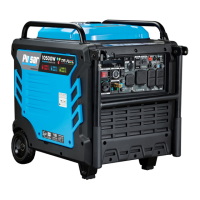10
Connect the Natural Gas (NG) Supply Line
Fire and explosion hazard. Never connect or disconnect the natural
gas hose while the engine is running. Do not smoke or create
sparks while handling natural gas. Always turn the engine off and
allow the generator to cool for at least ve minutes before
connecting to natural gas.
Never use a natural gas supply line, natural gas hose, or any other
fuel item that appears to be damaged.
● To reduce the risk of injury, perform a leak test any time the
natural gas hose is disconnected and reconnected.
● Explosion hazard. If you smell methane, do not start the
generator. Always completely close natural gas supply line valve
and disconnect natural gas (NG) hose from generator when not
in use.
1. Turn the generator off and allow the engine to cool for at least
ve minutes.
2. Verify that the gas is turned off at the natural gas supply line.
Preparation
NOTICE
WARNING
● All new propane tanks must be purged of air and moisture prior to
lling. Used propane tanks that have not been plugged or kept
closed must also be purged. The purging process should be done
by a propane tank supplier (propane tanks from an exchange
supplier should have been purged and lled properly).
● ALWAYS position the propane tank so the connection between the
valve and the gas inlet will not cause sharp bends or kinks in the
hose.
Explosion hazard. DO NOT start generator if you smell propane.
ALWAYS fully close the propane tank valve and disconnect the LPG
hose from the generator when not in use.
1. Turn the generator OFF and place on a at surface in a well ventilated
area.
2. Verify that the propane tank valve is in the fully closed position.
3. Remove the cover on the generator propane/natural gas inlet.
4. Use your ngers to hand thread the LPG hose (included) to the
propane inlet on the generator.
IMPORTANT: DO NOT use thread seal tape or any other type of sealant to
seal the LPG hose connection.
5. Tighten the LPG hose connector with an adjustable wrench until it is
snug. DO NOT over tighten.
6. Remove the safety plug or cap from the propane tank valve and attach
the other end of the hose to the LPG connector on the tank. hand-tighten.
7. Turn the propane tank valve to the fully open position. Check all
connections for leaks by wetting the ttings with a solution of soap and
water. Bubbles which appear or bubbles which grow indicate that a leak
exists. If a leak exists at a tting, turn the propane tank valve to the
fully closed position and tighten the tting. Open the propane tank valve
and recheck the tting with the soap and water solution. If the leak
continues or if the leak is not at a tting then DO NOT use the generator
and contact an authorized Pulsar service center.
DANGERDANGER
WARNING
WARNING

